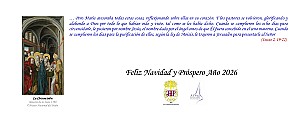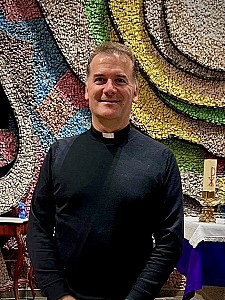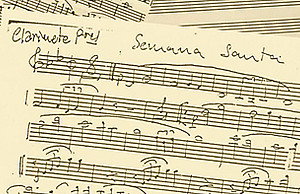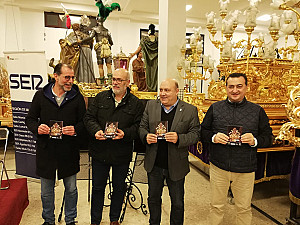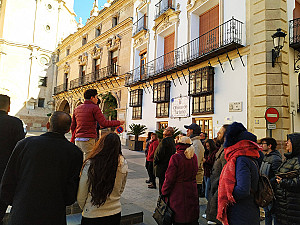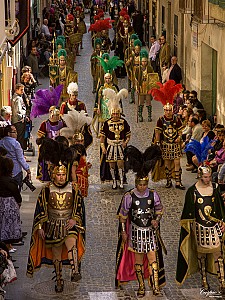Históricamente, aunque no como Cofradía del Tercio Romano del Santo Sepulcro, siempre estuvo ligada a la Imagen de Jesús Nazareno y al Prendimiento, de cuya organización era responsable; pese a ser una Cofradía reciente por su denominación, sus antecedentes hay que buscarlos en la Hermandad de la Convocatoria de Jesús, que, como tal, figura en 1914 en el Acta de Constitución de la Junta de Hermandades Pasionarias de Cieza. Su perseverancia, que les ha permitido no faltar a ninguna de las citas anuales con nuestra Semana Santa, los ha convertido en una de las tradiciones de mayor raigambre en nuestra ciudad, en la que popularmente se conocen como 'los Armaos'.
De la Hermandad de la Convocatoria de Jesús se conoce su presencia al menos desde principios del siglo XIX, aunque su origen puede ser anterior, por la larga tradición que ya se le atribuye en ese mismo siglo; incluso pudo haber sido en sus principios una Hermandad filial de la Cofradía de Jesús Nazareno, por la fuerte vinculación entre una y otra, o una parte integrante de aquella, lo que también explicaría que no aparezca en el catálogo de Cofradías realizado a raíz del Decreto del Conde de Aranda a finales del siglo XVIII. Su nombre deriva sin duda del hecho de que fuera ella la encargada de convocar a todo el pueblo para El Prendimiento, acto cuya existencia está constatada al menos de la misma época.
La Hermandad de la Convocatoria, muy arraigada entre los grupos sociales menos pudientes, fue, por otra parte, pionera en desempeñar funciones de índole social; conforme avanza el siglo XIX y de modo parejo a la desaparición de los gremios, algunas Cofradías, que por su propia naturaleza venían compaginando sus fines espirituales y de culto con cierta labor social derivada del mismo (como el acompañamiento y pago de entierros), comienzan a asumir otras competencias más propias de aquellas antiguas asociaciones gremiales al orientar parte de sus cometidos hacia la protección social, constituyéndose a finales de dicho siglo en una especie de primitivas mutualidades, de tal modo, dice D. Francisco. J. Salmerón Giménez en su artículo 'Una sociedad dividida en torno a la propiedad de la tierra' (Historia de Cieza Vol. IV: Cieza en el siglo XIX), que los miembros de tales Cofradías comienzan a encontrar también en estas una respuesta a "la necesidad de asegurar sus vidas y las de sus familias en caso de enfermedad o muerte". En este sentido en 1916 D. Mariano Ruiz-Funes en su obra Derecho consuetudinario y economía popular de la provincia de Murcia precisaba que "la más importante de todas estas Cofradías es la Convocatoria de Jesús, de Cieza, que socorre con una peseta diaria y asistencia médica a los cofrades enfermos. Forman su Junta Directiva: Un Hermano Mayor, Presidente, un Secretario, un Mandatario (cobrador), seis Vocales y varios inspectores de enfermos. Se pagan: 7,50 pesetas de derechos de entrada, 3 de tarja para los gastos procesionales y tantos repartos al año, a razón de 25 céntimos, por hermano, cuantos enfermos haya que socorrer. Tiene iguala con un médico, que presta asistencia a los socios y a sus mujeres. Al caer enfermo un asociado, los Inspectores de enfermos, previo aviso de él, envían al médico para que constate la enfermedad. Una vez que el médico la testifica, van ellos mismos al domicilio del cofrade a ver si es cierta la afirmación del médico. Si la enfermedad obliga al paciente a guardar cama, imposibilitándole absolutamente para el trabajo, le socorren; pero si puede mantenerse en pie, en condiciones de hacer trabajos manuales, retribuidos, en la industria local de la lía, le niegan la asistencia médica y la económica. Caso de prestarle socorro, lo hacen en la forma que hemos indicado; y si a los tres meses no se ha resuelto la dolencia, cesan en su protección. Si el enfermo muere, se pone en conocimiento de la Hermandad, y ésta envía la cera necesaria para velar el cadáver; después costea el entierro y misas por su alma".
'Los Armaos' constituían un grupo fuertemente jerarquizado: en el escalafón más alto se encontraba la figura del jefe o rey, hoy Capitán del Tercio, al que le corresponde por derecho la intervención oral en el Prendimiento y alrededor del cual se compone el resto de la tropa. A veces se les veía entrar por parejas en las tascas del barrio y allí mismo se hacia la leva. La tropa buscaba entonces al rey, ya que este no podía moverse de su casa sin una escolta; poco después iniciaban el Desfile con agudos de fanfarria, resonar de tambores y pasos fuertes en un gesto marcial.
Convocando al pueblo a las Procesiones de Semana Santa, su Banda de tambores y cornetas salía el Viernes de Dolores por la noche de su lugar de ensayo (como se oía decir "ya cinco días antes del Prendimiento iban en busca del Señor"), y tal era su constancia en dianas y pasacalles que dieron lugar al dicho "eres más terne que los Armaos"; en ese sentido se manifiesta el periódico local El Combate en su crónica de la Semana Santa de 1891: "Los soldados romanos o armados, como les llama el vulgo, han llenado con toda gravedad sus estrepitosas funciones, haciendo sus escursiones multiplicadas por esas calles, al redoble incesante de sus bandas de tambores y perdurable estridor de sus cornetas incansables, que tiene este vecindario continuamente en los oidos desde el miércoles en la tarde hasta esta misma mañana. Hay a quien displace este continuo tamboreo y este pertinaz toque de corneta; y a nosotros nos parece agradable, por ser él quizas la única nota saliente, característica, clásica, típica de las Procesiones de Cieza: que se supriman los Armados con sus bandas de tambores y cornetas, y parecerá como que han perdido su vida y animación las fiestas de Semana Santa en esta población. Hay que admirar a estos hombres que sin retribución de ninguna especie, antes bien haciendo gastos para ello, y empleando bastantes días los unos en aprender sus marchas y redobles, los otros sus evoluciones y ejercicios, se pasan luego tres mortales días con el casco y la coraza a cuestas, sin dar tregua a los pies, a las manos ni a los pulmones, multiplicándose incansablemente en todas partes: son unos beneméritos de las procesiones y salva la verdad histórica de su vestimenta, hacen un buen papel en ellas, con su gefe a la cabeza".
Durante el último cuarto del siglo pasado tienen su etapa de florecimiento, debido al buen hacer de D. Pedro Marín Martínez, impulsor de nuestras Procesiones. Es entonces cuando aparecen las carismáticas figuras del Maestro Muñoz, 'el Capitán Centellas' y de 'Requeñín', fiel ayuda de cámara del anterior, cuyo desfile despertaba entre las gentes admiración y respecto, y que pasaron a la leyenda de los mejores 'Armaos' por su entusiasmo y manera de vivir los acontecimientos de la Semana Santa como genuinos soldados romanos; su presencia daba el toque de solera y distinción precisas gracias a ese aura de misterio, marcialidad y firmeza de sus ademanes.
La hombres de la tropa, en cambio, con sus barbas postizas, sus corazas de hojalata o simples túnicas, y sus medias rosas propias de los toreros, caídas a veces, otras rellenas de serrín como pretendiendo dar idea de fortaleza, presentaban a veces un aspecto tan opuesto al de los auténticos soldados romanos que una crónica de El Orden de 1893 los describía como "los que, vestidos con el traje de soldados de Judea, aguardaban impacientes el momento de prender a Jesús".
Poco duró el esplendor de otra época posterior con Comino, rey en su tiempo, al que debemos otra genialidad de nuestro saber popular: "eres más constante que Comino", y en la que el desfile de los Armaos incorporó también caballos (1904-1905). En los años que precedieron a la guerra civil, se intentó denodadamente mejorar el vestuario, pero lo cierto es que, una vez acabada la misma, los 'Armaos' buscaban todavía su consolidación unas veces subvencionados por el Ayuntamiento, otras por la propia Junta de Procesiones. Así, en 1947 la Junta acuerda "autorizar a D. Julián Pérez Cano en unión de D. Antonio Pérez Gómez para gestionar la adquisición o confección de los trajes de Armaos para que en años sucesivos queden como propiedad de esta Junta, en la proporción de unos cincuenta números con sus accesorios, comprometiéndose la Junta de Procesiones a no usar en su beneficio de las subvenciones que en años sucesivos conceda el Municipio hasta que los Armaos no estén con el esplendor que todos deseamos, y que la Junta acuerde". Tres años después, el Ayuntamiento se hará cargo de gastos que pudieran ocasionar sus salidas, incluido el alquiler de dichos trajes y sus complementos, que a veces, como aquellos cascos con visera propios de un caballero de la Edad Media, no se correspondían con la época a que debían hacer referencia.
No obstante esta poco satisfactoria situación llevó en 1952 a un reducido grupo de ciezanos entusiastas a constituirse en la actual Cofradía, con total independencia de cualquier otra.
Los primeros gastos de la renacida Cofradía fueron sufragados gracias a las rifas y a los generosos donativos de numerosos ciezanos y entidades oficiales, destacando la gran ayuda prestada por D. Eulogio Marín Camacho, al que merecidamente se nombró Hermano Mayor de Honor. Presididos por D. Manuel Montoya Nieto, el grupo comienza a perfilar lo que iba a ser su columna vertebral: un número inicial de cuarenta y tres miembros, a los que en 1954 se le añadió su propia Banda de cornetas y tambores. Desde entonces y salvo alguna ocasión esporádica, como la de ese mismo año 1954, en que los Armaos escoltaron al Paso de La Flagelación y al del Santísimo Cristo del Consuelo en las Procesiones General y del Penitente respectivamente, su lugar siempre ha estado tras el Paso de Jesús Nazareno y, en la Procesión del Santo Entierro, tras El Santo Sepulcro, manteniendo también su participación hasta finales de la década de los setenta de este siglo en la Procesión de Jesús Resucitado como grupo de rompimiento de la misma.
En la década de los cincuenta la Cofradía confecciona un vestuario de rasos, sedas y terciopelos artísticamente bordados; cascos, corazas y armamento de metal repujado, obra del Maestro Penalva, insignias talladas en madera por el escultor Juan Solano, clarines de legítima factura y varias cuadrigas, enseres a los que se sumaría en 1971 un nuevo estandarte bordado en oro por la bordadora cartagenera Consuelo Escámez: así las cien personas que constituyen el cortejo la mañana del Viernes Santo de 1954 se permiten bordar a la entrada de la calle San Sebastián la tradicional 'Caracola', peculiar entramado de vueltas y revueltas de los hombres del Tercio en marcha, que había sido su distintivo propio desde tiempos inmemoriales y que hoy sigue siendo otro de los grandes atractivos de las Procesiones ciezanas. Desde entonces a esta parte se han sucedido muchos nombres... Antonio Alcaraz, 'El Nene de la Murciana'; Pascual Martínez, 'El Morena', José Yuste, 'El Cabo Vázquez'; o Juan Gómez, 'El Flecha'.
Precisamente en la última década del siglo XX, siendo presidente D. Carmelo Ramos, la Cofradía comienza a abordar la restauración de sus enseres; así, en 1997 el orfebre ciezano Francisco Penalva realiza nuevos carcajs para la cohorte de arqueros y restaura los fascios, en tanto que el artista local Bonifacio Pérez Ballesteros hace lo propio con las Insignias del Tercio. A partir de 1999, con el que era por aque entonces su Presidente, D. José Gómez Sánchez-Fortún, la Junta Directiva de la Cofradía intensificó ese proceso adquiriendo nuevos mantos, capas, petos y complementos para los Jefes de cohortes, renovando las túnicas y capas de la tropa, así como el vestuario (capas, túnicas y petos) de su también renovada Banda de cornetas y tambores, para la que la bordadora ciezana Concepción Fernández Yuste, según diseño de Mariano Rojas Marín, realizó en el año 2002 una nueva Bandera bordada en hilo de oro sobre terciopelo rojo y en la que por primera vez en 2006 y hasta 2010 se introdujeron instrumentos musicales. Finalmente, hace muy pocos años, el restaurador local José Javier Bernal Morote restauró la cuadriga.
Fotografía de Manuel Carpio.
© Junta de Hermandades Pasionarias de Cieza
